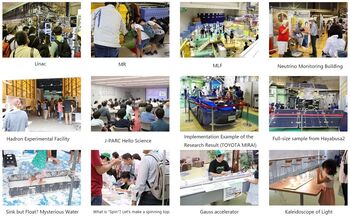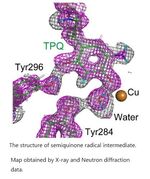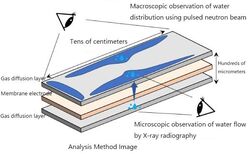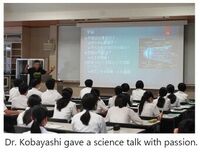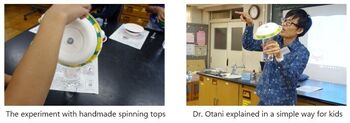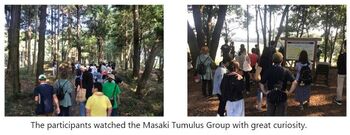J-PARC News November 2023 (Issue #222)
■Report on the Fire in the Hadron Power Supply Building of J-PARC
We deeply apologize for the concern and inconvenience caused to you by the fire in the Hadron Power Supply Building of J-PARC on June 22, 2023.
The J-PARC Center summarized the cause of the fire, countermeasures, and J-PARC wide safety confirmation as a report. We would like to inform the report was submitted to Ibaraki Prefecture on October 23.
Report on the Fire in the Hadron Power Supply Building of J-PARC (in Japanese)
https://j-parc.jp/c/information/2023/10/24001223.html
Takashi Kobayashi, Director of J-PARC Center
■J-PARC Facility Open House Held On-Site for First Time in Four Years (October 1)
Despite the unstable weather, 1,163 visitors attended the event. After a 4-year absence from the public, each of the J-PARC's facilities was very popular. The linear accelerator facility was especially popular, with all time slots fully booked in the morning. Visitors who were able to tour were awestruck by the sight of the acceleration cavities aligned 330 meters in a straight line. In the exhibition corner, special exhibits were displayed, including the experimental device that analyzed the rocks from the asteroid Ryugu brought back by the planetary prove Hayabusa2, and a cutaway model of a fuel cell car. Many visitors were interested in the exhibits and viewed them with great interest.
As part of J-PARC Hello Science, five lectures were given by the director of the J-PARC Center and researchers, introducing the status of J-PARC, the latest research and results, etc.
■Neutron Crystallography Reveals Detailed Structure Information of Enzyme Radical Reaction Intermediates for the First Time (September 20)
A research group from Osaka Medical and Pharmaceutical University, Osaka University, National Institutes for Quantum Science and Technology, University of Tsukuba, Ibaraki University, and RIKEN has successfully performed neutron crystal structure analysis of the semiquinone radical intermediate formed in the catalytic reaction pathway of copper amine oxidase using the iBIX, IBARAKI Biological Crystal Diffractometer installed in the MLF, the Materials and Life Science Experimental Facility at J-PARC.
Copper amine oxidase is an enzyme that exists in many organisms, and it has recently been shown to be involved in the development of diabetes, arteriosclerosis, and neurodegenerative diseases in human blood. Although it is known that this enzyme undergoes multiple structural changes, forming different intermediates to catalyze the reaction, the mechanism by which the structure changes has not yet been elucidated. Also, it was not known how the intermediate could stably maintain the reactive radical.
The research group generated a semiquinone radical intermediate by soaking a microorganism-derived copper amine oxidase crystal in a substrate amine solution under anaerobic conditions. They then performed neutron diffraction measurements using iBIX. By succeeding in high-resolution neutron crystal structure analysis, the position of the hydrogen atom at the active site was revealed, and it was possible to clarify one aspect of the mechanism by which the radical intermediate can stably exist.
This study revealed one aspect of the precise reaction mechanism of the enzyme at the atomic level. As a major research theme in the field of enzyme science, it is expected to significantly contribute to the development of design molecules of enzymes with new functions, especially various useful enzymes that use radical reactions as intermediates.
For more information, please visit the J-PARC website.
https://j-parc.jp/c/press-release/2023/09/20001209.html(only in Japanese)
DOI: https://doi.org/10.1021/acscatal.3c02629
■Elucidating Water Behavior Inside Automotive Fuel Cells
- World's first observation using neutrons and X-rays - (October 11)
A research group consisting of Toyota Central R&D Labs, JAEA, and the Comprehensive Research Organization for Science and Society (CROSS)has successfully revealed the behavior of water inside practical-sized automotive fuel cells using the energy resolved neutron imaging system "RADEN" at J-PARC and the Toyota beamline "BL33XU" at SPring-8.
To improve the power generation performance of fuel cells, it is necessary to develop a technique that efficiently discharges the water produced by the chemical reaction of hydrogen and oxygen inside the cell. Consequently, understanding how water is retained in and discharged from fuel cells is an essential issue. This is because fuel cells are installed in a metallic case, which prevents direct observation of the behavior of water inside, it has been predicted by means of computational simulations. Thus, there has been a strong demand for experimental observations under practical operation conditions.
At first, using a practical-sized cell from Toyota Motor Corporation's MIRAI (2nd generation) FCEV, the macroscopic water distribution was observed during power generation using a pulsed neutron beam at J-PARC. The results evidenced the water distribution, which was predicted by the simulation. Next, a hand-sized cell was fabricated using the same electrode material as the practical cell, and the water behavior in the lamination direction was observed using synchrotron X-rays at SPring-8. Based on the observation using both neutrons and X-rays, it was found that the microscopic water behavior significantly affected the macroscopic water distribution in practical cells.
The technique to analyze the water behavior for automotive fuel cells developed in this study can be applied to analyze the stagnant water that affects the performance of fuel cells. Furthermore, various developments are expected in the research and development of fuel cells, such as the planning and verification of concepts for materials and gas channels.
For more information, please visit the J-PARC website.
https://j-parc.jp/c/press-release/2023/10/11001218.html (only in Japanese)
DOI: https://doi.org/10.1021/acsenergylett.3c01096
■Scientific Activities for Kids at Ozora Marche (October 7, Tokai Village)
The Ozora Marche, one of the four major festivals of the Tokai Village, was held under calm weather. This event is annually held in a historical and nostalgic location, with the precincts and approach of the adjacent "Grand Shrine" and "Muramatsusan Kokuzoudo" as the venue. J-PARC Center held a demonstration of an original toy coaster using superconducting materials and a workshop on making kaleidoscopes using polarizing sheets.
The J-PARC booth attracted 373 visitors. They were amazed and delighted by the strange behavior of superconducting materials and the kaleidoscope made by themselves.
It was a lively event for people of all ages, with a variety of activities including workshops, crafts, food trucks, and musical performances,
so that this facility's open house can be a fruitful one for both visitors and staff.
■J-PARC Center Director Kobayashi Gives Guest Lecture at Tsuyama Junior High School (September 20)
Takashi Kobayashi, Director of the J-PARC Center, gave a guest lecture at Tsuyama Junior High School in Tsuyama, Okayama Prefecture. Tsuyama City is the central city of northern Okayama Prefecture, near Dr. Kobayashi's hometown. Tsuyama Junior High School is the first combined junior high and high school in the north of Okayama. On the day of the lecture, 79 third graders attended a talk on "The Mysteries of the Vast Universe, the Mysteries of the Microscopic World, and Accelerators.
Dr. Kobayashi began by explaining the relationship between the vast universe and the tiny particles that make it up. He explained that large accelerators are needed to observe these tiny particles. He then introduced J-PARC and talked about the excitement of learning science. He expressed his hope that students would take this opportunity to become more interested in the world of science.
■KIPP Nakameguro Children's Class Held at Nakameguro Elementary School (October 11)
A lecture entitled "Let's Make the World's Smallest Mysterious Top and Touch the World of Elementary Particles!" was held at Nakameguro Elementary School in Meguro Ward. Dr. Masashi Otani of the Accelerator Division was the lecturer, and 14 students from grades one to four learned about the universe and elementary particles clearly and concisely. In the gyroscope experiment, the children were engaged in trying to spin the top as long and as beautifully as possible. They also realized that precession occurs due to differences in how the top is spun. In the handmade tops experiment, they enjoyed experimenting with their own ideas, such as connecting large and small tops together.
According to a post-lecture survey, there were responses such as "I learned for the first time that there are protons and elementary particles" and "I learned for the first time about precession." It seems that the children were able to touch the world of elementary particles while enjoying the experiment.
■Exploring Sizeable Ancient Burial Mounds with the "Muographic Investigation of Ancient Burial Mounds in Tokai※ (September 17)
On September 17, 34 participants visited Funatsuka Tumulus Group 2, Gongenyama Tumulus, and Masaki Tumulus Group in Tokai Village.
While it was still hot, the participants enjoyed the explanations and quizzes given by Mr. Nakaizumi and Ms. Hayashi, curators of the Tokai Village Museum, as they viewed the ancient burial mounds. Participants looked very happy to be able to step into an ancient burial mound, as they do not usually have the opportunity to climb them. They were also surprised by the size and height of the actual tumulus. During the tour of Funatsuka Tumulus Group 2, which was to observe through cosmic ray muons, participants went inside the tumulus covered with grass and trees and very dense. The children were thrilled to feel as if they were exploring the area, which must have touched their hearts.
In addition, Ms.Hayashi found a fragment of haniwa (clay figurine) in the Funatsuka Tumulus Group 2, and the children were very interested in haniwa and wanted to pick one up themselves.
This month marks the end of this year's lectures and site visits, and now the second half of the year will begin with activities to build the actual measuring instruments. We will report on these activities in due course.
※This is a project sponsored by Tokai Village, J-PARC Center, Ibaraki University, and Tokyo Metropolitan University, which started in April this year.
■Sanpomichi ㊴ -Early Morning Open House at the J-PARC Facility![]()
The first visitors lined up in front of the reception tent at 6 a.m. in the rain. By the time the reception began, 80 people were in line. Drivers boarded the 12 buses and waited for departure. Visitors completed their registration at the Japan Atomic Energy Agency headquarters and boarded a shuttle bus to the J-PARC Facility Open House venue.
The Facility Open House is an opportunity for everyone to learn about J-PARC. However, it is not a one-way event that simply showcases the facilities and equipment. During the Facility Open House, J-PARC staff can hear directly from visitors about what they are interested in and what they expect from J-PARC. This is a valuable opportunity to improve our outreach activities in the future. In addition, we may find unexpected novel ideas from the questions and comments that visitors provide. We hope to listen to the voices of the visitors and share wisdom with each other.
The shuttle buses carrying a lot of people left one after another. We hope that this facility open house can be a fruitful one for both visitors and staff.

